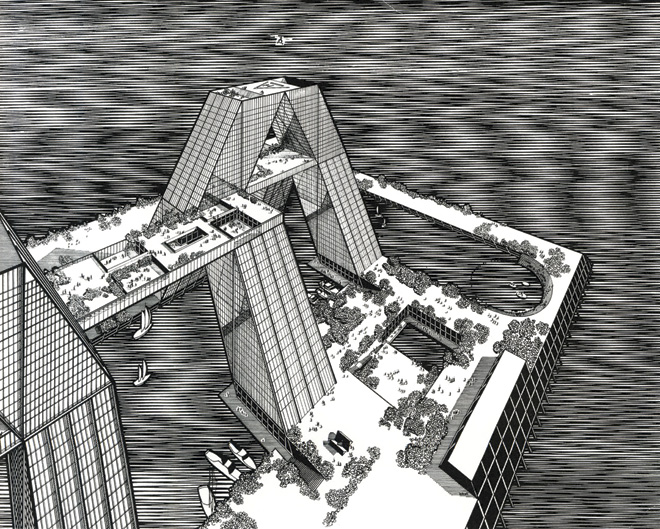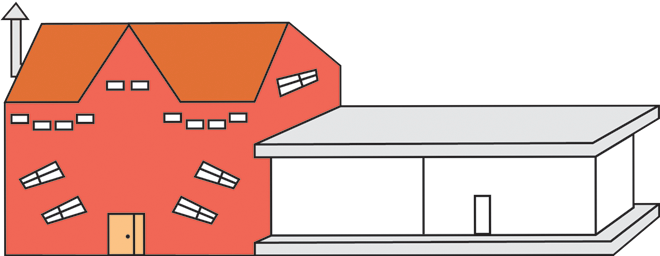
It was the uncompromising and individualist hero of Ayn Rand’s novel “The Fountainhead” that inspired Stanley Tigerman to become an architect. “I read the book when I was about 12 or 13,” Tigerman remembers in his 2011 autobiography “Designing Bridges to Burn.” “And I thought, this is what the fuck I’m going to do.”
Having flunked out of MIT, Tigerman returned to school years later to complete an accelerated bachelor’s and master’s degree at Yale in two years.
“When I saw in the Yale Daily News that Ayn Rand was giving a lecture, I got my buddies in the master’s class and we went to see her. Afterward, stupidly, forgetting her well-known antagonism towards selflessness, I went to introduce myself. I said ‘My name is Stanley Tigerman, I’m at the graduate school in architecture. Reading your book as a child really impacted my life and I just wanted to thank you for getting me here.’ And she looked at me in that New York snotty way, up and down, and said, ‘So what?’”
At the ripe age of 81, Tigerman is Chicago’s notorious black swan of contemporary architecture. His bold iconoclasm and eclectic style challenge the established modernist tradition and have opened Chicago to a new generation of architects. “Tigerman will be remembered for insisting that architecture is not only about aesthetics,” writes Yale curator Emmanuel Petit, “but also about ethical responsibility.”
It was a dreary Monday afternoon when I made my way through the empty streets along the Chicago River to the office of Tigerman McCurry architects. We sat down over coffee at a table piled high with stacks of books – “The Architecture of Exile,” “Versus,” “Building After Auschwitz,” “Cultural Amnesia,” “MetaMouse.”
“I’ve always felt myself an outsider, ein Ausländer, if you will,” Tigerman explained. “In Genesis 12, God commands Abram to ‘Go forth from your country.’ It’s like parents pushing a child out of the crib into an unfamiliar place called adulthood, which, because it is alien, forces you to find your own way. So all of us émigrés that came out of Europe made for ourselves in the United States a name – we created anew.”
“Would you design a concentration camp?
Would you design a villa for a dictator?
Would you design housing in a metropolitan
area at a density greater than you knew to
be functional? And how much money would
it take to change your mind?”
A descendant of Hungarian Jews who emigrated to America, Tigerman was born and raised in Chicago. His family was poor – his father swept leaves in Lincoln Park, while his mother was a government service clerk. In the evenings, he would follow his grandfather to the smoke-filled Hungarian coffeehouses on Chicago’s west side to play pinochle, schmooze and sip schnapps.
“The place of my birth always felt alien to me. Part of it is because I am a Jew and part of it is because my parents were very poor, so when I went to the Reform Temple Sholom, I was the poorest kid there. Being a poor Jew compounds it – you face not only anti-Semitism but anti-poverty.”
Tigerman grew up during the years of the Great Depression in a three-story boarding house owned by his grandmother. The house in Edgewater hosted a colorful cast of characters – Al and Bud, two black blue-collar workers, lived in the basement and small room behind the kitchen. The first floor was occupied by bachelor uncle Mitoh and the worldly young women he brought home each night. Harriet, the Jewish call girl, lived on the second floor and high in the attic, tucked under the third floor gable, Tigerman’s grandfather smoked cheap cigars and labored over Talmudic exegesis in his dirty long johns.
“In these surroundings,” Tigerman reflects in his memoir, “I was exposed prematurely to a naked level of poignant cultural diversity rarely offered to cloistered, over-protected middle-class Jewish children.”
The experience of estrangement cultivated a self-awareness, criticality and rebellion evident in Tigerman’s rampant challenge of tradition and authority. In his 1978 photo collage “Titanic,” Tigerman confronts the rigid hegemony of Mies van der Rohe. In an attempt to undermine “Miesolatry,” the endless and sterile repetition of the German master’s modernist designs, Tigerman sinks the iconic IIT architectural school Crown Hall in the waters of Lake Michigan.
“Stanley was trying to shake architecture,” explains fellow architect Robert Stern, “but I suppose just as much as anything, to shake himself free of that influence.”
Unlike Mies, who proclaimed architecture as “the will of the epoch translated into space,” Tigerman believes the architect should not only reflect his epoch, but challenge and mold it.
He advocates access to good design for those who rarely enjoy its benefits. “I love working for a group that normally doesn’t receive the designs of an architect,” Tigerman confesses. “I don’t do marketing. So whatever comes in the door is what I get. But I’m happier when those who come in the door have real, not imagined, problems, where poignancy is built into the program of a building. That is more interesting as opposed to designing villas in the suburbs for rich princes and princesses.”
Tigerman poses a series of questions to illustrate his insistence on the ethical responsibilities of architecture: “Would you design a concentration camp? Would you design a villa for a dictator? Would you design housing in a metropolitan area at a density greater than you knew to be functional? And how much money would it take to change your mind?”

In 1966, former Yale classmate Mazharul Islam invited Tigerman to East Pakistan (contemporary Bangladesh) to design five polytechnic institutes. With the support of the “American Trio” – Louis Kahn, Paul Rudolph and Stanley Tigerman – Islam proposed to reinvigorate the city of Dhaka as a modern center of architecture, politics, culture and economy.
Islam and Tigerman collaborated over the following decade on the design of the Bangladesh Polytechnic Institutes in five jungle villages surrounding Dhaka. The Bengali vocational training centers were built to develop East Pakistan’s natural resources of jute, cotton and gas.
The two architects faced the challenge of translating American modernist architecture into the context of a subcontinental Asian rainforest. Unaccustomed to dealing with the local conditions of fungus, algae and mold, Tigerman turned for solutions to native building materials, such as teak and bricks made from clay found along the banks of the Brahmaputra and Ganges rivers.
Growing political discontent and nationalist fervor led to the 1971 Bengali war for liberation. East Pakistan’s struggle for an independent Bangladesh was met with the brutal resistance of West Pakistan.
“Through threats, searches and check-points, in combination with the presence everywhere of police and the army, the martial law authorities have created an atmosphere that is tantamount to a ‘police state,’” declared Tigerman in a 1971 Calcutta press conference. The architect refused to work for a military government and officially resigned from the polytechnic commission.
Only after the establishment of the People’s Republic of Bangladesh did Tigerman agree to complete the project.
Tigerman argues that architects should be held to a high level of public, social and ethical responsibility. His concern for housing the geographically marginalized black population led to the development of the largest low-rise, low-cost housing project in the U.S. He designed the 504-unit Woodlawn Gardens as a corrective to the Chicago Housing Authority’s disastrous high-rise projects.
“We were limited by our own zealotry,” Tigerman acknowledges in retrospect. “The desire to resolve need in and of itself led to a purely functional design devoid of humor.”
Tigerman understands his architecture as a failed attempt at healing an incurable wound. “There is a deep terror to confront ‘the other.’ But what choice do you have as an ethical being but to look the other person in the eye and do something on their behalf, not your own.”
A retrospective of Tigerman’s idiosyncratic architecture opens January 26 at the Graham Foundation. “Ceci n’est pas une rêverie” (This is not a dream) exhibits a chaos of texts, sketches, cartoons, architectural drawing and models, spanning Tigerman’s zealous, half-century-long career.
Jan. 26—May 19
Graham Foundation
4 W. Burton Place
grahamfoundation.org







